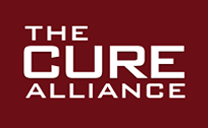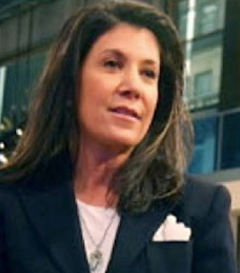
President: Shelley Ross
Shelley Ross was named President of The Cure Alliance in 2009 after a chance meeting with founder, Dr. Camillo Ricordi that led to energized discussions of how to execute his vision of a non-profit organization that could tear down barriers to curing all modern disease. “Why don’t we cure diseases anymore?” was his haunting rhetorical question. He had a list of reasons and she believed she could provide public awareness and effective messaging with her decades- long experience in print and broadcast news.
Ross is a three-time Emmy award-winning television news producer/executive who worked at NBC, CBS and 17 years at ABC News, where she is best known for her tenure as sole executive producer of Good Morning America, bringing in the anchor team of Diane Sawyer and Charles Gibson, supported by a fresh team of correspondents: Jake Tapper, Robin Roberts, Jim Sciutto, John Miller, Brian Ross, Lara Spencer, George Stephanopoulos and more, plus a reinvigorated team of diverse producers who today populate executive suites across broadcast news and media corporations.
Ross began her network career in 1981 as a segment producer for NBC’s Tomorrow Show with legendary host Tom Snyder. Three weeks into her first job, she booked and produced the network’s most controversial broadcast: the first-ever interview with convicted mass cult murderer Charles Manson who she learned was up for parole. That show tripled the ratings in the history of the late-night time slot.
Attracting mass audiences quickly became her signature and wherever she worked, she ensured compelling storytelling and a growth in the ratings. While her skill sets sharpened with experience, she credits her story selection, detailed reporting and the unique story angles with her success. In 1990, the second story she produced for ABC News’ PrimeTime Live, “Murder In Beverly Hills,” won a News and Documentary Emmy Award, beating the tough competition of 60 Minutes, 20/20 and more. Behind the scenes, there was controversy and a harsh pushback to giving network airtime to a story of two privileged sons accused of killing both their parents. Ross and anchor Diane Sawyer argued that “In Cold Blood” won the Pulitzer Prize. It was still a surprise and possibly the start of a new era when “Murder in Beverly Hills” won an Emmy.
While Ross teamed with Diane Sawyer for the next 17 years, she also produced for legendary co-anchor Sam Donaldson. Together they exposed how they “cook the books” when it comes to who gets the profits from Hollywood blockbusters. They then produced a series of Pentagon exposés on sexual harassment in the military, a subject not yet explored in broadcast news. Their first exposé revealed the debauchery, harassment and sexual assault of women at the annual Navy Tailhook convention in Las Vegas. The behavior had gone on for years, until a young female admiral’s aide was forced down a gauntlet of drunken navy guys grabbing her body parts. The morning after “Tailhook” aired, President George H. W. Bush ordered the Secretary of the Navy to the White House and asked him to resign and new policies were instated.
“The Enemy Within” exposed the Navy’s mysoginistic rape reporting policy which included a 56-point questionnaire nicknamed “Were you really raped?” One example, “Have you ever had financial trouble?” (Isn’t that why most people join the navy?) That questionnaire was banned and no longer were women who were sexually assaulted encouraged to return home to their families.
Our broadcast of secret video tapes obtained from Marine Corps sources resulted in the first official anti-hazing policy ever in that Navy branch. The shockingly graphic tapes were recorded during the months of training to select the next inductees of the prestigious Marine Corps Silent Drill Team. Those who were selected for the team, after months of grueling training, were stripped naked, had their hands and feet bound with duct tape, their genitals painted with toxic military shoe polish that burns the skin and doesn’t wash off, before they are sent down a gauntlet where others wearing gas masks pour containers off a foul mixture of urine, feces, dead rats that have been buried and baking in the desert. The videos showed blood curdling screams of tough marines, while officers were interviewed in their rooms nearby feigning ignorance.
The final Ross/Donaldson Pentagon exposé closed down the Bermuda Naval Air Station after revealing it had no military purpose but was used as a “club med” for the Navy brass. One random weekend, Admiral Henry H. Mauz, Jr., the commander-in-chief of the Atlantic fleet, had arrived with his wife on a government plane from Norfolk, Virginia to celebrate his wedding anniversary. Using hidden cameras, we followed him to restaurants, on the golf course, to an 8-course tasting meal. Posing as tourists with my traveling companion wearing the hidden camera, the Admiral easily engaged in a friendly chat about the Naval Air Station: “Do you have lots of planes?” None,” he answered. “Ships?” “None.” Then what goes on here? “We help the British run the airport and we’ve been building a $100M hangar that was authorized so many years ago, they don’t know how to stop it. In the end, the Bermuda Naval Air Station was closed, and Admiral Mauz retired early, docked one star. Taxpayers saved $100M a year.
June 3, 1994 was the date scheduled for an exclusive interview with Paula Corbin Jones, the first woman to sue a sitting president (Clinton) for sexual harassment. ABC bosses challenged the newsworthiness of letting “just anyone” who wants to accuse the president of wrongdoing to go on camera. Ross’ booking letter was their best argument: “Dear Paula, If you want to be believed, don’t sit down with Katie, Connie, Leslie, Diane or Barbara. Sit in the hot seat across from the toughest interviewer in Washington, D.C., Sam Donaldson, and show you’re not afraid to answer any questions.” This was then treated like the interview of the year.
The in-depth interview took place in a private home in D.C., after which Donaldson and Ross set out to fact check and edit the interview until air the following Thursday night. Not so fast. That Sunday night, June 4th, another story was breaking in L.A. O.J. Simpson’s wife had been murdered along with a friend and they were looking for O.J. Paula Corbin Jones certainly wasn’t destined to be the biggest story of the year. By Thursday night. she wasn’t even the lead. After. the broadcast, legendary ABC News Chairman Roone Arledge ordered Ross back to L.A. to take charge of the O.J. Simpson story for the four regularly scheduled ABC news magazines plus any related specials in primetime. For the next 18 months, ABC News poured seemingly unlimited resources into a rotating team of reporters, producers, bookers, and editors and top camera crews 24/7 who would work under Ross from their our own production building, across from the ABC News bureau, with three edit rooms, a sound recording booth, even a kitchen.
In all, the team filed 102 stories, many exclusives such as the Brown family and the Goldmans, Chris Darden, Marcia Clark, Mark Furhman, Kato Kaelin. Barbara Walters nicknamed it “Shelleywood.”
On November 2, 1998, the NABET (National Association of Broadcast Engineers and Technicians) union strike triggered a lockout in the Los Angeles bureau. Ross flew to New York to visit Diane Sawyer who had just landed an exclusive interview with Ken Starr, special counsel appointed to investigate Bill & Hillary Clinton scandals. They brainstormed in Diane’s kitchen, then Ross was invited “off campus” to a brainstorming session to fix Good Morning America which was suddenly in a ratings free fall.
There, executives were convinced Ross had the “secret sauce.” And in a few short weeks, she was offered the executive producer job. Good Morning America was relaunched on January 18, 1999 with Ross’ stated vision and Charlie Gibson returning to the anchor chair alongside Diane Sawyer.
On April 20, 1999 news broke of the Columbine school shooting in Colorado. Ross had been the lead reporter on the ground for previous school shootings in Jonestown, Arkansas and Pearl, Mississippi ensuring all the exclusives. Columbine was the first time she would have to rely on her new morning staff. Katie Couric was live on the scene, out-booking everyone. “No one’s talking,” the ABC producer reported. “No one’s talking to us,” Ross suspected.
They failed that morning, but Ross didn’t concede a total loss of the news cycle. She flew to Washington D.C., took meetings in the White House and five weeks after the Columbine school shootings, GMA broadcast a 2-hour show on gun violence live from the White House with President Bill Clinton and First Lady Hillary Clinton. It began with Charlie Gibson interviewing the President Mano y Mano in the cabinet room. At some point, the President pounded his fist on the table in frustration, a photo that put Good Morning America on the front page of the New York Times for the first time. The rest of the broadcast included a town hall meeting of student survivors of gun attacks, victim families, plus a live performance from Sarah McLachlan of “Angel” on the Mall.
Many epic broadcasts followed, as part of a strategy to get hardline and habitual fans of the Today Show to sample GMA. This included a first-ever live broadcast from the Tower of London honoring Queen Elizabeth’s accession to the throne 50 years earlier. A first-ever live broadcast from the Vatican commemorating Pope John Paul II”s 25 years as Pontiff, including an exclusive look at “the room of tears” where the newly chosen Pope is taken to be outfitted in his new clothing and to humbly reflect on the meaning of the moment.
Ross commanded the Good Morning America Times Square studio, on-air live, on 9/11/2001 when hijacked terrorist planes hit the World Trade Center in downtown Manhattan. She fed the anchors research information from the first attack on the World Trade Center by the terrorist known as the Blind Sheik. The first eyewitness on air was her national correspondent, Don Dahler, who lived down town and called in his stunning report reminiscent of Edward R. Murrow’s radio reports during WWII. The GMA control room remained “hot” for hours after Peter Jennings and the ABC special events team took the lead. All the calls being returned to GMA, including Mayor Rudolf Guiliani, were patched through to Jennings. Diane Sawyer remained in the anchor chair as did Ted Koppel in Washington D.C. as all newsrooms were thought to be potential terror targets. Cynthia McFadden was sent to the nearest hospital, only to report no patients were arriving. Soon after the Towers fell, George Stephanopoulos and his producer returned from downtown to the control room, covered head to toe in the thick white dust we would learn was a mixture of crumbled building material and human remains. For the foreseeable future, Good Morning America went on the air live every day from 6:00 a.m. to noon. For their coverage of 9/11, the entire ABC News team was awarded the George Peabody award for excellence – the most prestigious broadcast journalism award.
For the following year, we chased every lead on terror cells, homeland security, the build up to the shock and awe campaign, the funerals, the heroes, and the babies born to the widowed moms.
On November 9, 2001, just two months after the terrorist attacks in America, Good Morning America became the first television show ever to broadcast live from an aircraft carrier during wartime. Diane Sawyer and Charlie Gibson anchored the two-hour show from the U.S.S. Enterprise in an undisclosed location somewhere in the Gulf. They talked to the airmen who had dropped bombs on Afghanistan wrapped with special notes on behalf of the Firefighters who perished on 9/ll. The carrier had been on a training mission for months before 9/11 and its sailors and airmen were in full lockstep when called to duty. The live broadcast was a critical success and a technical feat with 40 miles of cable said to have been dropped.
On the one-year anniversary of 9/11, GMA became the first news show to broadcast live from the Pentagon, the section that had been destroyed by the terrorists and rebuilt.
While the “fun” Today Show had been #1, viewers were now regularly sampling GMA and they stayed. In under six years, income revenue at GMA grew from $19M to nearly $100M a year. The ratings came within a whisper of the popular Today Show, with most of the growth in Ross’ last two years.
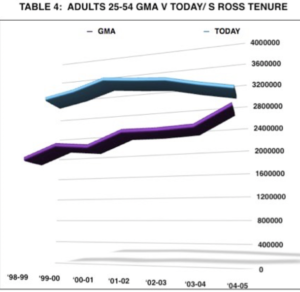
In February 2003, three wells before the invasion of Iraq, Sawyer and Ross traveled to the Gulf Region and reported live from Camp New York, the U.S. base set up in Kuwait across the Iraqi border. They were driven in a bullet-proof security car to Jordan where Diane met with Queen Rania, then traveled to Baghdad to interview the notorious scientist known as “Dr. Germ,” the architect of Saddam Hussein’s weapons of mass destruction. Driving around Bagdad, just three weeks before the U.S. began bombing, we were forbidden by our government “minders” to take photos of buildings and bridges that soon would no longer be standing. Immediately after the interview, Ross smuggled the tapes back to Jordan, transcribing them on the floor of the back seat of a non-bullet proof car. She edited the interview and sent it back to the States. (Sawyer peppered Dr. Germ with tough questions, showing her Secretary of State Colin Powell’s sketches of mobile WMD units he presented to the U.N Security Council just days earlier. Dr. Gern denied Iraq had any WMDs, which, strangely, turned out to be true.)
In 2005, Ross was named Executive Producer of Primetime Live, a position she tried to turn down due to the waning interest in a weekly news format. She had led the charge to capitalize on the 24/7 news cycles created by cable news. Viewers now turned into the morning shows first thing to see if a plane hit a building, if another political scandal had erupted overnight. Readership of Time and Newsweek had plummeted as well: breaking news wouldn’t be told for a weekly print magazine either. Their covers turned to thoughtful evergreen ideas: Does God Exist?
The overpopulation of network news magazine shows, cheaper to produce than dramas, found over one dozen primetime shows fighting for the same stories and bookings. ABC News competing shows relied on a coin toss for stories, and an aggressive booker like Ross wasn’t going to leave success to fate. Finally, David Blaine asked the network for Ross to be freed from her news responsibilities to work with him on his ABC entertainment special. It had been four years since his last special and ABC was eager for him to fulfill his multi-special commitment. Ross talked Blaine out of his working concept to live on a high wire for a week and instead guided him to turn his special into “Drowned Alive” where the illusionist would spend a week in a human aquarium in the middle of Lincoln Center, then, on live TV try to break the human breath hold record of 8:06. It became a week-long tourist destination, people taking photos with their hands on the sphere on the other side of David. The event was not a stunt or illusion. For months Blaine was trained by international dive champions who held various breath-hold records. He actually changed the shape of his body to increase his lung capacity, all recorded for the special. He also sought daredevil mentoring from Evil Knievel and more. Blaine had trained to beat the record, and had done it in practice, so without telling anyone, he decided to secretly up the challenge for himself; he would hold his breath while trying to get out of handcuffs. Of course, this was insane as no matter how gracefully he could slip out of the cuffs, it would still eat up valuable stored oxygen in his blood. As he struggled, he lost consciousness at 7:34 and the viewer could see the release of the breath by the air bubbles pouring out of his mouth. The rescue team pulled him out within seconds, making sure to cover his mouth and nose so he wouldn’t ingest water into his lungs. As he was lifted up, his hands shook with tremors as he waved to the crowd and was taken away by ambulance to a nearby hospital, Ross riding with him. Ross and Blaine began a lifelong friendship and she would later produce his first live theatrical tour across Asia.
In October 2006, Ross was hired as Senior Executive Producer of CBS’ The Early Show which had been in third place for 42 years. Within the first 15 weeks, Ross’ Early Show passed Good Morning America in male viewers, a demographic her former bosses had wrongly written off years earlier due to the growth of ESPN and CNBC. In just 26 weeks she grew her morning audience by 195,000 new adult viewers (male and female age 25-54) while GMA lost over 50,000 viewers and Today around 20,000.
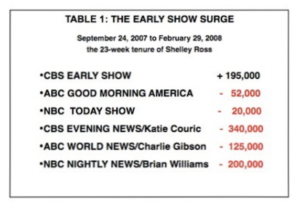
In the evening, the CBS Evening News with Katie Couric lost 340,000 during the same dates. This drop, while sharing the same correspondents, camera crews, news desk assistants, graphic department, promotion department and network executives as The Early Show. ABC’s Charlie Gibson and NBC’s Brian Williams also lost a significant audience. In fact, The Early Show was the only daily news broadcast to gain viewers.
Still, after just 23 weeks, Ross, who had radically changed the show, the story selection, the competitive bookings, the set, the open, the music, graphics, pacing and more, read in the Sunday New York Times that she was being fired. The next day she was told the only reason for her success was the strong news cycle of the upcoming presidential election. which she knew wasn’t true since no other show had benefited. She left the building that day, and for the next few years, including the morning after the election of Barack Obama, The Early Show never matched the ratings Ross achieved.
For Ross, it marked the end of a successful decades-long network run, the last 7 of which were bone-crushing sleep-deprived years getting up at 3:30 a.m. to reinvent morning news shows while producing the current one.
Which brings us back to that chance meeting with Dr. Camillo Ricordi over a Sunday brunch with friends in Manhattan. Here was the scientist who was going to cure diabetes and believed all modern diseases were the result of faulty regulation of the immune system. He shared an amazing story about saving the life of a young soldier who had been shot point blank at a military outpost in Afghanistan and wound up on an operating table at Andrews Air Force base where military surgeons took instructions from Dr. Ricordi over the internet to save his life.
Ross and Ricordi were an enthusiastic team, beginning their mission in Washington, D.C., to support the 21st Century Cures Act, the last bill signed into law during the Obama Administration. Their satisfaction was limited when Ross discovered $500M had changed hands amongst lobbyists to get a compromised bill. What that could fund in research.
Ross became an instant advocate for scientists and patients alike. She testified before the FDA to protect patients against proposed regulations that would restrict access to certain new regenerative medicine discoveries that could promote healing and in many cases replace surgery. For those efforts, Ross and The Cure Alliance were awarded the 2018 World Stem Cell Summit’s Stem Cell and Regenerative Medicine Action Award for Advocacy. Former Vice President Joe Biden and Dr. Jill Biden were also honored as citizen advocates that year.
During the COVID-19 pandemic, she raised awareness and helped Dr. Camillo Ricordi launch an important clinical trial infusing UC-MSCs to heal the most severe lung damage. The phase II/b double blind trial was 100 successful among COVID-19 patients under 80 who got the medicine.
After the urgency of the pandemic quieted down, Ross urged her membership to get back to their original missions. She raised money to re-start one clinical trial using a combination of generic drugs to halt pancreatic cancer. The original trial had been halted by the pandemic. Today, enrollment has re-opened at SUNY Downstate and is listed on www.clinicaltrials.gov.
The Cure Alliance has also funded the first human diabetesT1 patient to undergo an islet cell transplant with a new antibody replacing the toxic anti-rejection drugs used as standard care with great challenges.
Ross is also helping The Cure Alliance move into the future with Longevity Medicine, to help people avoid getting chronic, debilitating and fatal diseases.
OTHER SIGNIFICANT PROJECTS
Executive Producer/Director:
2010 PBS 4Troops Live at the Intrepid, 4Troops were four veterans who all saw active duty in Iraq. The group’s CD of the show stayed on the Billboard Chart for 6 weeks, peaking at #36.
Executive Producer
- 2012 Nik Wallenda walks on a high wire over Niagara Falls
- 2013 Nik Wallenda walks on a high wire across the Grand Canyon
- 2014 Nik Wallenda walks on a high wire across two Chicago skyscrapers, once blindfolded
- 2019 Nik Wallenda walks on a high wire across Times Square
- 2020 Nik Wallenda walks on a high wire across deadly active volcano in Masaya, Nicara
Ross also discovered the music group, The Piano Guys, and participated in the signing, developing and creative launch of the group who would become an internet sensation, tour the world, earn gold records and make stunning videos from the Great Wall of China to Iguaçu Falls straddling Argentina and Brazil. Ross produced and co-directed their 2012 PBS concert special: ”The Piano Guys: Live at Red Butte” for Sony Masterworks.
BOOKS
- 1987 Simon & Shuster MS: What it is, Who Gets it and Why by Dr. Louis R. Rosner, Professor of Clinical Neurology at University of California, Los Angeles and Shelley Ross. Other editions published in 1992, 2011.
- 1988 Ballantine Books Fall From Grace: the History of Sex, Scandal and Corruption in American Politics from 1702 to the Present by Shelley Ross
- 2020 Scruffy Publishing SCRUFFY: Our Pandemic Pooches and the Good, the Bad and the Crazy Haircuts We Gave Them by Shelley Ross. A photographic coffee table book, still in print, with all proceeds going directly to clinical trials funded by The Cure Alliance.
Ross currently has two non-fiction streaming series in development with studios.
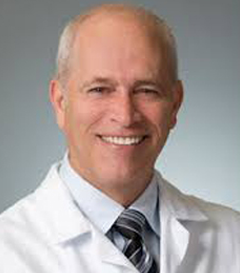
SECRETARY: DR. F. CHARLES BRUNICARDI
Dr. Brunicardi brings more than three decades of experience in academic medicine and patient care, serving on the faculty at three medical schools and as Chair of two departments of Surgery and Vice-Chair of another.
Dr. Brunicardi is currently Senior Vice President and Dean of the College of Medicine at SUNY Downstate where he serves as the head of the COVID-19 task force. He joined SUNY in December 2019 from the University of Toledo where he served as Chair of Surgery and Academic Chief of Surgery for the ProMedica Health System, roles in which he still serves. Additionally, he has served as Director of the Cancer Program since 2017 and was named the John Howard Endowed Professor of Pancreatic Cancer Research in 2018. Since 2018, he has been serving as a medical director of the Ebeid Social Determinants of Health Institute at ProMedica; he previously was the Department of Cancer Biology Interim Chair during 2018-19, as well as the Department of Cancer Biology Professor in 2018.
Before joining the University of Toledo, Dr. Brunicardi was the Jerry Moss Professor of Gastrointestinal Surgery and Vice-Chair of Surgery at the David Geffen School of Medicine at UCLA. His other notable past appointments include serving as the DeBakey-Bard Professor and Chair of the Michael E. DeBakey Department of Surgery, George Jordan Professor and the Founding Chief of the Division of General Surgery, Founder and Director of Elkins Pancreas Center at the Baylor College of Medicine, and as Chief of Surgical Services, Methodist Hospital, Houston, Texas.
Dr. Brunicardi also served as the Founding Director, Human Islet Program, UCLA/VA Medical Center, Chief, General Surgery Group, and Vice-Chair for Surgical Services, UCLA-Santa Monica Medical Center and Orthopaedic Hospital. He was Surgical Director, UCLA Center for Gastrointestinal Diseases, UCLA-Santa Monica Center and Orthopaedic Hospital, and Founder and Executive Director of the UCLA Santa Monica Breast Center.
Dr. Brunicardi has been a continuously funded researcher since 1992. His research has been supported by the National Institutes of Health/National Cancer Institute as well as by a variety of foundations, including the Jerry Moss Foundation and most recently the Hal Federman Foundation and the Mel and Jeannie Miller Foundation, as well as the Ohio Department of Medicaid where he serves as PI on a Medicaid Equity Simulation Project. His research has broadly focused on genomic translational medicine and surgery and specifically on pancreatic cancer. He holds several patent applications related to early detection and targeted treatment of pancreatic cancer and neuroendocrine tumors, among others.
His clinical expertise includes GI surgery, precision therapy for pancreatic cancer, and hernia repairs using minimally invasive and robotic surgery. Dr. Brunicardi has published 304 papers and has served as the Editor-in-Chief of Schwartz’s Principles of Surgery since 2000. The 11th edition of Schwartz’s Principles of Surgery, considered the world’s leading surgical textbook, was published in March 2019.
Dr. Brunicardi earned his undergraduate degree in Chemistry with Honors at the Johns Hopkins University and his medical degree at Rutgers University School of Medicine. Dr. Brunicardi has been perennially listed among the nation’s “Top Doctors” by Castle Connolly, Ltd. and is a member of numerous professional and medical associations. He is often invited as a speaker for visiting professorships and medical and scientific presentations.
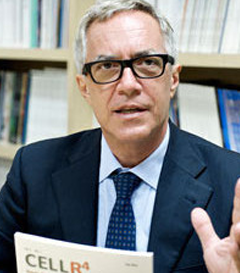
Treasurer/Founder: Dr. Camillo Ricordi
Camillo Ricordi, M.D. is Professor of Surgery, Distinguished Professor of Medicine, Professor of Biomedical Engineering, and Microbiology and Immunology at the University of Miami (UM), Florida, where he serves as Chief of the Division of Cellular Transplantation, Department of Surgery, Director of the Cell Transplant Center and Director Emeritus of the Diabetes Research Institute (DRI). Ricordi has been serving as Medical Director of the NIH funded cGMP (current Good Manufacturing Practices) Advanced Human Cell and Biologic Product Manufacturing Facility since 1993, that has been providing an invaluable service distributing human tissues, cells and other biologic products, for research and clinical applications at UM, in the US and worldwide.
Acknowledged by his peers as one of the world’s leading scientists in diabetes cure-focused research, cell transplantation and regenerative medicine, Ricordi is well-known for inventing the machine that made it possible to isolate large numbers of islet cells (insulin-producing cells) from the human pancreas and for performing the first series of successful clinical islet allotransplants that reversed diabetes after implantation of donor purified islets into the liver of recipients with diabetes. The procedure is now used by laboratories performing clinical islet transplants worldwide. In addition to diabetes cure -focused research, Ricordi’s interests include the definition of anti-inflammatory nutrition, protective substances and regenerative medicine strategies, to prevent or treat chronic degenerative disease conditions, and to prolong healthy lifespan (Healthspan).
Ricordi led the team that performed the first successful transplants of a bioengineered endocrine pancreas implanted within a 3D bioactive resorbable scaffold in the abdominal cavity of recipients with a severe form of Type 1 Diabetes and chaired for over a decade the steering committee of the first successful, NIH funded, FDA Phase 3 multicenter trial. He has also developed highly innovative strategies with the objective to transplant cells and organs without the continuous requirement for anti-rejection drugs and for the reversal of autoimmune disease conditions. He led the international team that successfully completed the first FDA approved double blind, randomized controlled trial to treat the most severe cases of COVID-19 with mesenchymal stromal cell infusions that resulted in 91% patient survival at one month compared to 42% survival in the control group. Ricordi has also launched the program www.Fit4Healthspan.org to help the general population become resistant to severe viral infections through nutrition, fitness and selected protective molecules. These strategies are now also studied to prevent or halt progression of autoimmune diseases and age related chronic degenerative conditions, to prolong healthy lifespan (healthspan).
He is currently serving as SC Chairperson and UM-DRI Principal Investigator of the stem cell derived islet transplant trials (Vertex; VX-880) and within an immune-isolating device (Vertex; VX-264) without anti-rejection drugs. Ricordi is also working with iTolerance towards the first trial of stem cell derived islets within a tolerance inducing microgel, without chronic recipient immunosuppression (proof of concept trial planned for 2025).
Ricordi was founding president of the Cell Transplant Society and of the International Association for Pancreas and Islet Transplantation (IPITA) and served on the board of The Transplantation Society and the American Society of Transplant Surgeons. He served on the FDA Biologic Response Modifiers Advisory Committee, and has been serving on several NIH study sections, in addition to serving as an advisor/reviewer of several international funding agencies.
Ricordi has received numerous honors and awards, including the 2001 World Prize in Surgery (University of Geneva) for developing a technology that significantly contributed to the advancement of a surgical field. He was awarded the 2002 Outstanding Scientific Achievement Award by the American Diabetes Association and in 2009 was Knighted by the President of the Republic of Italy. In 2010 he was the only surgeon and one of the few ever inducted into the Association of American Physicians (AAP), and in 2018 he was inducted into the National Academy of Inventors USA for contributing outstanding inventions that have made a tangible impact on quality of life, economic development, and welfare of society.
Ricordi ranked as #1 world expert in transplantation of insulin producing cells for treatment of diabetes, for the decade 2008-2018 (expertscape), among over 4,000 surgeons, physicians and scientists evaluated, and was appointed to the Supreme Council of Health (Consiglio Superiore di Sanita’) by the Ministry of Health of Italy. He has also served on several editorial boards and is currently serving as Editor-in-Chief of European Reviews for Medical and Pharmacological Sciences.
In 2023 he was awarded the Leonardo Da Vinci Award (co-shared with Nobel Prize winners Yamanaka and Semenza – Taormina TaoBuk) and the Venice Golden Lion Award.
Ricordi also serves as President of the Board of ISMETT (Mediterranean Institute of Transplantation and Advanced Therapies and was appointed President of Fondazione Ri.MED by the Italian Prime Minister, for the 2013-2017 term, successfully completing the partnership with ISMETT for the creation of an unprecedented biotechnology center linked to ISMETT to foster clinical translation of novel therapeutics (http://www.fondazionerimed.eu/content/progetto-CBRB.aspx).
Ricordi was founding president of The Cure Alliance and Chairman of the Diabetes Research Institute Federation, coordinating and promoting cure focused research at leading institutions worldwide. Ricordi serves as consultant and/or on the board of advisors of several non-profit foundations, government and federal agencies, venture capital and investment funds, as well as pharmaceutical and biotechnology corporations.
Ricordi contributed over 1,170 publications, received over 54,000 citations, had 114 H-index and 28 patents awarded.
In 2022 he published the Oscar Bestseller Mondadori book “IL CODICE DELLA LONGEVITÀ SANA” now available also in its English edition: “THE HEALTHSPAN CODE” (Amazon.com).
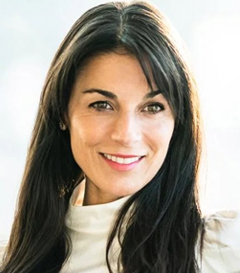
Board Member: Patricia Silverstein
Patricia Silverstein has been named to the board of The Cure Alliance after her years of dedication to fundraising for diabetes, kidney disease, and other humanitarian causes.
Born in Barcelona, Spain, she developed a business and sales career that reached to Australia. She eventually moved to New York where she became a counselor and certified life coach under her own brand, Coaching X Humanity.
Three years ago, Patricia’s younger sister became debilitated by acute diabetes, which she had battled since age six. Now, the disease was quickly worsening, impacting her sight and kidneys, and threatening amputations. Patricia knew in one phone call that she would dedicate her time and resources to help her sister overcome the complications of her disease and support scientists with novel innovations.
Patricia launched her first fundraiser in August 2021, The Hamptons Garden Gala, raising funds from her backyard patio, which financed the first pilot trial done in the US to cure kidney disease and improve diabetes with stem cell therapy infusion. Her sister was the recipient of the treatment developed for the clinical trial, which proved to be an important step on the way to a cure. The Hamptons Garden Gala remains one of the most successful fundraising events in the Hamptons for Diabetes Research.
Patricia also founded the Silverstein Dream Foundation, a non-profit organization that supports Diabetes Research and Respiratory illnesses.
In December 2022, she became the first woman honoree elected in the history of the Foundation at the Empire Ball Gala, hosted by the Diabetes Research Institute Foundation in New York.
As a member of The Cure Alliance Board, she has pledged a personal lifetime goal to help scientists find a cure for diabetes by raising awareness and funding through innovative strategies. Her broad network, boundless energy, and personal commitment is a proven formula for success.
